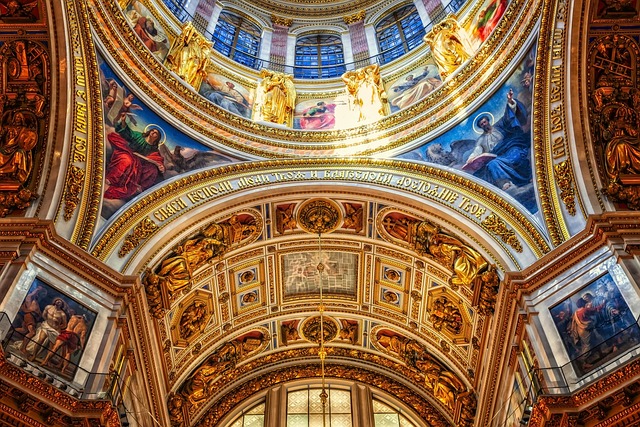The Orthodox Christian cross, also known as the Eastern Orthodox cross or the Russian Orthodox cross, is a distinctive symbol used in the Orthodox Christian faith. It is a variation of the Christian cross, representing the crucifixion of Jesus Christ. The Orthodox Christian cross has specific features and symbolism that distinguish it from other Christian crosses. In this introduction, we will explore the characteristics and meaning of the Orthodox Christian cross.
Table of Contents
The Symbolism Behind the Orthodox Christian Cross
The Orthodox Christian cross is a powerful symbol that holds deep meaning for those who follow this faith. It is a symbol that is instantly recognizable, with its distinctive shape and design. But what does it really mean? What is the symbolism behind the Orthodox Christian cross?
At first glance, the Orthodox Christian cross may appear similar to other Christian crosses, with its vertical and horizontal bars intersecting. However, there are some key differences that set it apart. The most notable difference is the presence of three horizontal bars, rather than just one. This is known as the Russian Orthodox cross, and it is the most commonly used cross in the Orthodox Christian tradition.
The symbolism behind the three horizontal bars is rich and profound. The top bar represents the sign that was placed above Jesus’ head on the cross, which read “Jesus of Nazareth, King of the Jews.” This bar serves as a reminder of Jesus’ kingship and his ultimate sacrifice for humanity. It is a symbol of his victory over sin and death.
The middle bar represents the actual crossbeam on which Jesus was crucified. It is a symbol of the physical suffering and pain that Jesus endured for the salvation of mankind. It serves as a reminder of the immense love and compassion that Jesus had for humanity, and his willingness to lay down his life for others.
The bottom bar represents the footrest on which Jesus’ feet were nailed. It is a symbol of Jesus’ humanity and his connection to the earth. It serves as a reminder that Jesus was fully human, experiencing the same joys and sorrows that we do. It also represents the idea that Jesus came to earth to bring salvation to all people, regardless of their social status or background.
In addition to the three horizontal bars, the Orthodox Christian cross also features a slanted bar at the bottom. This bar is often interpreted as a representation of the spear that pierced Jesus’ side after his death on the cross. It is a reminder of the suffering and sacrifice that Jesus endured for the forgiveness of sins.
The Orthodox Christian cross is not just a symbol of suffering and sacrifice, but also of hope and resurrection. It is a symbol of the victory of life over death, and the promise of eternal life for all who believe in Jesus Christ. It serves as a reminder that even in the darkest of times, there is always hope and redemption.
For Orthodox Christians, the cross is not just a symbol to be worn or displayed, but a reminder of their faith and commitment to following Jesus. It is a symbol that holds deep meaning and significance, and serves as a constant reminder of the love and sacrifice of Jesus Christ.
In conclusion, the symbolism behind the Orthodox Christian cross is rich and profound. It represents Jesus’ kingship, his suffering and sacrifice, his humanity, and the hope of resurrection. It is a symbol that holds deep meaning for those who follow this faith, serving as a constant reminder of their commitment to following Jesus and their belief in his love and salvation.
The History and Evolution of the Orthodox Christian Cross

The Orthodox Christian cross is one of the most recognizable symbols in the world. It is a powerful representation of faith and has a rich history that dates back centuries. In this article, we will explore the history and evolution of the Orthodox Christian cross, shedding light on its significance and meaning.
The origins of the Orthodox Christian cross can be traced back to the early days of Christianity. The cross, as a symbol, became widely used after the crucifixion of Jesus Christ. It was a powerful reminder of his sacrifice and the redemption he brought to humanity. Over time, different variations of the cross emerged, each with its own unique design and symbolism.
One of the most common variations of the Orthodox Christian cross is the Russian Orthodox cross. This cross features three horizontal bars, with the top bar representing the sign that was placed above Jesus’ head during his crucifixion. The middle bar represents the crossbeam on which Jesus was nailed, while the bottom bar represents the footrest. This design is often seen in Russian Orthodox churches and is a prominent symbol of their faith.
Another variation of the Orthodox Christian cross is the Greek Orthodox cross. This cross features a slanted crossbeam, symbolizing the balance between heaven and earth. It is believed to have been inspired by the shape of the letter “chi” in the Greek alphabet, which is the first letter in the word “Christ.” The Greek Orthodox cross is widely used in Greece and other regions influenced by Greek Orthodox traditions.
In addition to these variations, there are many other types of Orthodox Christian crosses, each with its own unique design and symbolism. Some crosses feature intricate carvings or engravings, while others are more simplistic in their design. Regardless of the specific design, the Orthodox Christian cross serves as a powerful symbol of faith and devotion.
Over the centuries, the Orthodox Christian cross has evolved and adapted to different cultural and artistic influences. In some regions, crosses are adorned with precious gemstones or intricate metalwork, reflecting the wealth and opulence of the church. In other regions, crosses are made from simple wood or metal, emphasizing the humility and simplicity of the Christian faith.
Today, the Orthodox Christian cross continues to be a powerful symbol of faith for millions of people around the world. It is worn as a pendant, displayed in churches, and used in religious ceremonies. The cross serves as a constant reminder of Jesus’ sacrifice and the hope and salvation he offers to all who believe in him.
In conclusion, the Orthodox Christian cross has a long and storied history. It has evolved and adapted over the centuries, taking on different forms and designs. Regardless of its specific variation, the cross remains a powerful symbol of faith and devotion for Orthodox Christians worldwide. It serves as a constant reminder of Jesus’ sacrifice and the redemption he brought to humanity.
Different Variations of the Orthodox Christian Cross
The Orthodox Christian cross is a powerful symbol that holds deep meaning for believers. It is a visual representation of the crucifixion of Jesus Christ and serves as a reminder of his sacrifice and resurrection. While the basic design of the cross remains the same, there are different variations of the Orthodox Christian cross that hold unique significance.
One of the most recognizable variations is the Russian Orthodox cross. This cross features three horizontal bars, with the top bar representing the sign that was placed above Jesus’ head on the cross. The middle bar represents the wooden beam that Jesus was nailed to, while the bottom bar represents the footrest. This cross is often adorned with intricate designs and is a common sight in Russian Orthodox churches.
Another variation is the Greek Orthodox cross, which is characterized by its slanted bar. This slant is said to represent the inclination of Jesus’ head as he hung on the cross. The Greek Orthodox cross is often seen as a symbol of humility and is widely used in Greek Orthodox churches and communities.
The Serbian Orthodox cross is another variation that holds special significance. It features a unique design with four Cs, which are said to stand for the phrase “Only the Cross Saves.” This cross is often worn as a pendant or displayed in Serbian Orthodox churches as a symbol of faith and salvation.
In addition to these variations, there are also regional variations of the Orthodox Christian cross. For example, the Ethiopian Orthodox cross is known for its distinctive shape, with a circular top and three horizontal bars. This cross is often made from wood or metal and is highly revered in Ethiopian Orthodox churches.
The Coptic Orthodox cross, on the other hand, is characterized by its simple and minimalistic design. It consists of a single bar with a small loop at the top, representing the crown of thorns placed on Jesus’ head. This cross is widely used in Coptic Orthodox churches and is seen as a symbol of Christ’s suffering and victory over death.
While the variations of the Orthodox Christian cross may differ in design, they all share a common purpose – to serve as a reminder of Jesus’ sacrifice and resurrection. They are symbols of faith and hope, and they hold deep meaning for believers around the world.
In conclusion, the Orthodox Christian cross comes in different variations, each with its own unique design and significance. From the Russian Orthodox cross to the Greek Orthodox cross, these variations serve as powerful symbols of faith and devotion. Whether worn as a pendant or displayed in a church, the Orthodox Christian cross is a constant reminder of Jesus’ sacrifice and the hope of salvation.
The Significance of the Orthodox Christian Cross in Modern Worship
The Orthodox Christian cross holds great significance in modern worship. It is a symbol that represents the core beliefs and values of Orthodox Christianity. The cross is not just a piece of jewelry or a decorative item; it is a powerful reminder of the sacrifice and love of Jesus Christ.
When we look at the Orthodox Christian cross, we see a unique design that sets it apart from other crosses. It consists of three horizontal bars, with the top bar being shorter than the other two. This design is known as the Russian Orthodox cross, and it has a deep spiritual meaning.
The top bar of the cross represents the sign that was placed above Jesus’ head during his crucifixion. It reads, “Jesus of Nazareth, the King of the Jews.” This sign was meant to mock Jesus and his claim to be the Messiah. However, for Orthodox Christians, it serves as a reminder of Jesus’ kingship and his victory over sin and death.
The two longer bars of the cross represent the arms of Jesus stretched out in love and sacrifice. They symbolize his willingness to bear the weight of the sins of the world and to offer himself as a sacrifice for humanity. This aspect of the cross is central to the Orthodox Christian faith, as it emphasizes the importance of Christ’s death and resurrection in the salvation of mankind.
In addition to its unique design, the Orthodox Christian cross is often adorned with other symbols and images. These include the letters IC XC, which stand for “Jesus Christ” in Greek, and the letters NIKA, which mean “victory.” These symbols further emphasize the triumph of Christ over sin and death.
The Orthodox Christian cross is not just a symbol of Christ’s sacrifice; it is also a reminder of the believer’s own journey of faith. When Orthodox Christians make the sign of the cross, they touch their forehead, chest, and both shoulders. This action represents the believer’s desire to align their thoughts, heart, and actions with the teachings of Christ.
The act of making the sign of the cross is a common practice in Orthodox worship. It is done at the beginning and end of prayers, during the liturgy, and in various other moments of worship. This simple gesture serves as a constant reminder of the believer’s commitment to follow Christ and to live according to his teachings.
In conclusion, the Orthodox Christian cross holds great significance in modern worship. Its unique design and symbols remind believers of Christ’s sacrifice, victory, and their own journey of faith. The act of making the sign of the cross serves as a constant reminder of the believer’s commitment to follow Christ and to live according to his teachings. So, the next time you see an Orthodox Christian cross, take a moment to reflect on its deep spiritual meaning and the love and sacrifice it represents.
Conclusion
The Orthodox Christian cross is a symbol that holds significant religious and cultural meaning for Orthodox Christians. It consists of a vertical line intersected by a shorter horizontal line near the top, representing the crucifixion of Jesus Christ. The top bar represents the sign that was placed above Jesus’ head, which read “Jesus of Nazareth, King of the Jews.” The Orthodox Christian cross serves as a reminder of Jesus’ sacrifice and is a symbol of faith and salvation for Orthodox Christians worldwide.



